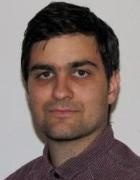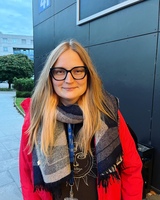Dichte und seltsame hadronische Materie
Prof. Laura Fabbietti
Forschungsgebiet
We are working mainly on strange things, which sounds maybe odd but it refers simply to particles containing a strange quark.
Why is the study of mesons and baryons with a strange content relevant for the human kind? One of the pioneering ideas behind this study was the hypothesis that neutron stars might have a condensate of strange particles in their core. Astronomers look at neutron stars and determine their mass and radii, we collide nuclei in the laboratory and try to produce high density environments, to measure there strange particles and help theoreticians in constraining models for neutron stars... among other things.
Mitarbeiterinnen und Mitarbeiter der Arbeitsgruppe
Professorin
| Photo | Akad. Grad | Vorname | Nachname | Raum | Telefon | |
|---|---|---|---|---|---|---|

|
Prof. Dr. | Laura | Fabbietti | 001 | +49 89 289-12433 |
Sekretariat
| Photo | Akad. Grad | Vorname | Nachname | Raum | Telefon | |
|---|---|---|---|---|---|---|

|
Petra | Zweckinger | 005 | +49 89 289-12434 |
Wissenschaftlerinnen und Wissenschaftler
| Photo | Akad. Grad | Vorname | Nachname | Raum | Telefon | |
|---|---|---|---|---|---|---|

|
Ph.D. | Igor | Altsybeev | – | – | |

|
Luca | Barioglio | – | +49 89 289-14344 | ||

|
Daniel | Battistini | – | +49 89 289-12563 | ||

|
Ph.D. | Ante | Bilandzic | – | – | |

|
Ph.D. | Raffaele | Del Grande | – | +49 89 289-14344 | |

|
Dr. | Jürgen | Friese | 005 | +49 89 289-12501 | |

|
Sergei | Golenev | – | – | ||

|
M.Sc. | Maximilian | Horst | – | +49 89 289-12488 | |

|
M.Sc. | Tobias | Jenegger | – | +49 89 289-12547 | |

|
M.Sc. | Thomas | Klemenz | – | +49 89 289-14356 | |

|
M.Sc. | Stephan | Königstorfer | – | +49 89 289-12488 | |

|
Dr. | Valentina | Mantovani Sarti | – | +49 89 289-12563 | |

|
Dr. | Dimitar | Mihaylov | 162 | +49 89 289-12563 | |

|
Chiara | Pinto | – | +49 89 289-12488 | ||

|
M.Sc. | Lukas | Ponnath | 172 | +49 89 289-12547 | |

|
M.Sc. | Anton | Riedel | – | – | |

|
M.Sc. | Laura | Serksnyte | – | +49 89 289-14344 | |

|
M.Sc. | Bhawani | Singh | – | +49 89 289-12563 | |

|
Seyed Farid | Taghavi | – | +49 89 289-14344 | ||

|
M.Sc. | Berkin | Ulukutlu | – | +49 89 289-12488 | |

|
Dr. | Laszlo | Varga | – | – |
Studierende
| Photo | Akad. Grad | Vorname | Nachname | Raum | Telefon | |
|---|---|---|---|---|---|---|

|
Jerameel Samuel | Franco Scarpati | – | – | ||

|
B.Sc. | Maximilian | Korwieser | – | – | |

|
Maria | Leibelt | – | – | ||
Andere Mitarbeiterinnen und Mitarbeiter
| Photo | Akad. Grad | Vorname | Nachname | Raum | Telefon | |
|---|---|---|---|---|---|---|

|
Emma | Chizzali | – | +49 89 289-12563 | ||

|
Lorenzo | Gasbarri | – | – | ||

|
Dr. | Piotr | Gasik | – | – | |

|
Dipl.-Phys. | Philipp | Klenze | – | – | |

|
Ralf | Lang | 129 | +49 89 289-12426 | ||

|
Ph.D. | Oton | Vazquez Doce | – | – | |

|
Jannik | Wirth | – | – |
Lehrangebot der Arbeitsgruppe
Lehrveranstaltungen mit Beteiligung der Arbeitsgruppe
Abgeschlossene und laufende Abschlussarbeiten an der Arbeitsgruppe
- Cluster Characterization and Alignment Strategies for Cylindrically Bent MAPS Detectors
- Abschlussarbeit im Masterstudiengang Physics (Applied and Engineering Physics)
- Themensteller(in): Laura Fabbietti
- Characterization of a Multi-Channel-THGEM detector for photon detection
- Abschlussarbeit im Bachelorstudiengang Physik
- Themensteller(in): Laura Fabbietti
- First Multiplicity and mT Dependent Measurement of the Size of the Emission Source in pp Collisions at √s = 13.6 TeV with ALICE
- Abschlussarbeit im Masterstudiengang Physik (Kern-, Teilchen- und Astrophysik)
- Themensteller(in): Laura Fabbietti
- Exploring Digital Readout Techniques for Amplitude Measurement Using MAPS-Based Sensors
- Abschlussarbeit im Masterstudiengang Physik (Kern-, Teilchen- und Astrophysik)
- Themensteller(in): Laura Fabbietti
- Investigation of DLC as a photocathode material for gaseous light detectors
- Abschlussarbeit im Bachelorstudiengang Physik
- Themensteller(in): Laura Fabbietti
- Comparison of the STAR Au--Au antideuteron measurement with a Wigner function based coalescence model
- Abschlussarbeit im Masterstudiengang Physics (Applied and Engineering Physics)
- Themensteller(in): Laura Fabbietti